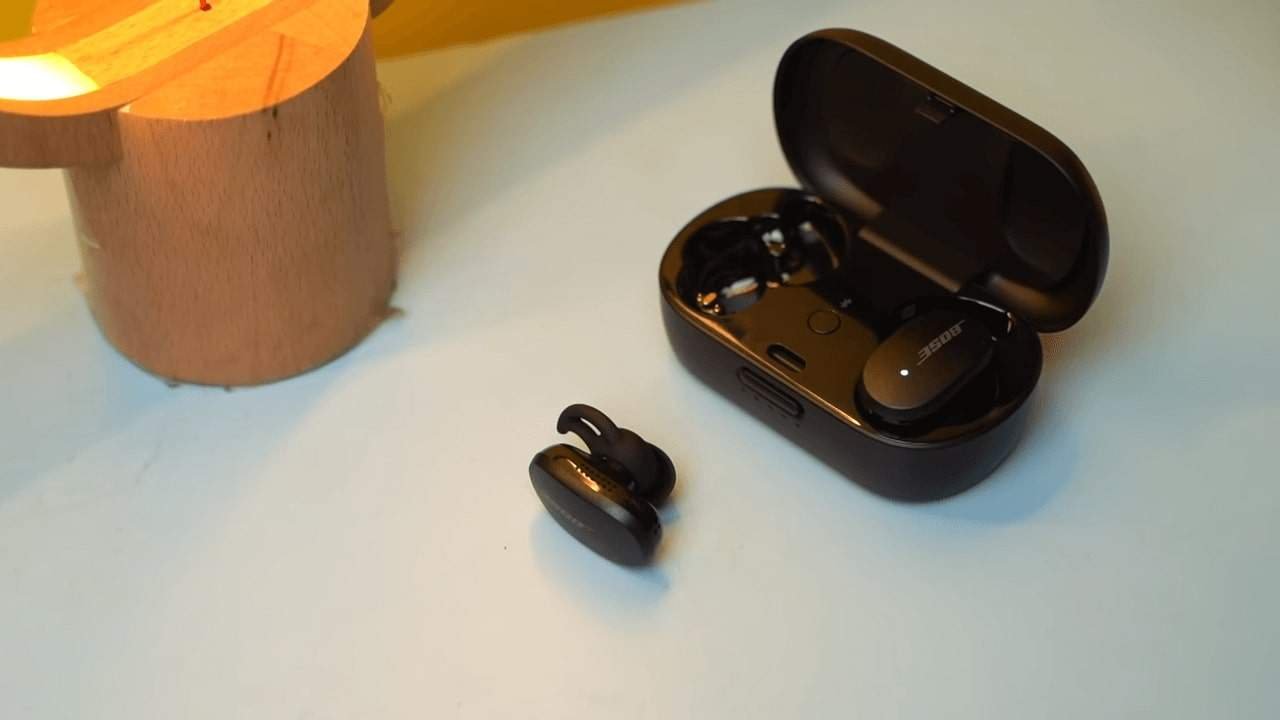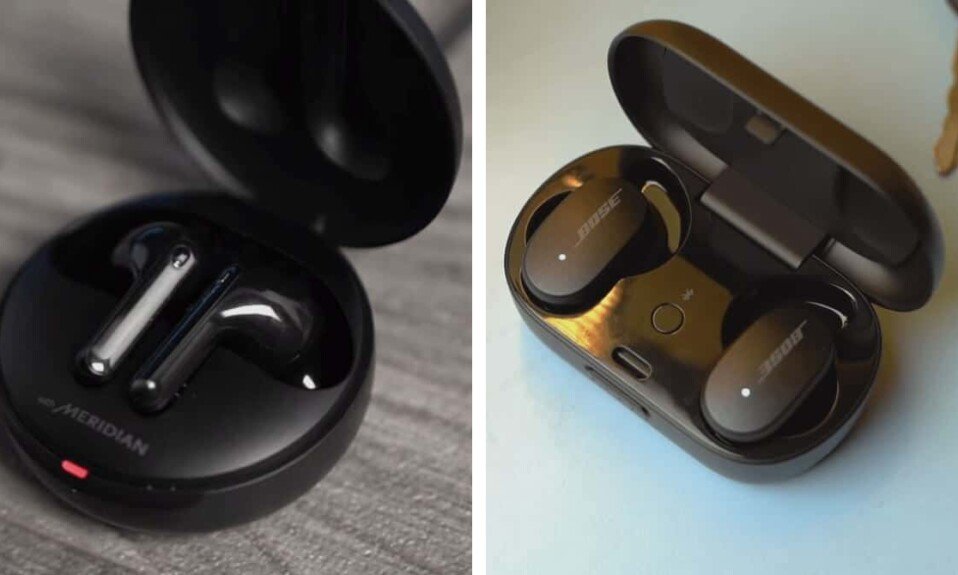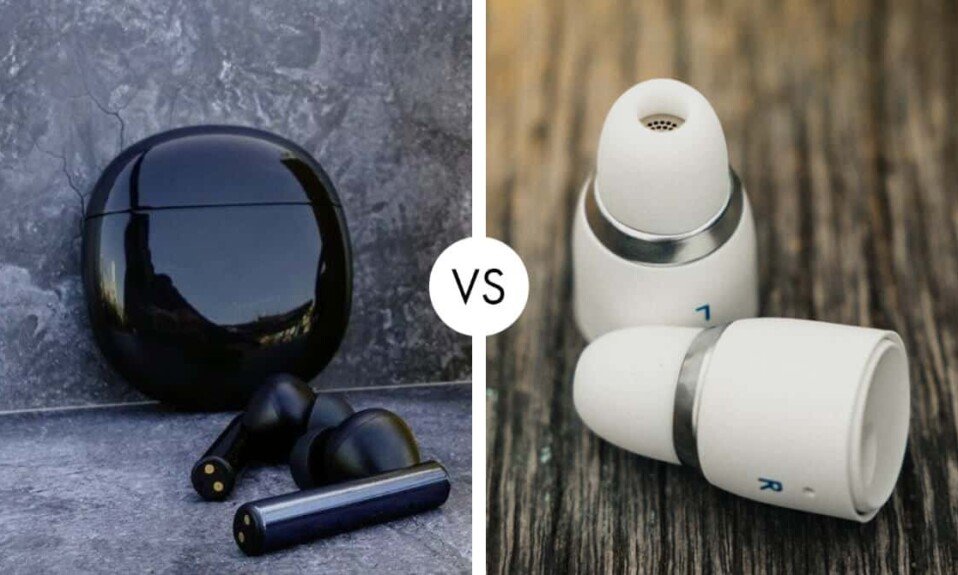Very intriguing headphones, with the main argument being an antibacterial UV light system in their charging box, LG’s HBS-FN6 headphones were quite an interesting experience, ended up failing to be above the fray. ANC version (active noise reduction), the Tone Free HBS-FN7 promises practically the same experience but in greater silence.

The QC Earbud, Bose’s first noise-canceling wireless headphones, have arrived. The American manufacturer, yet inventor of noise cancellation technology, is one of the last manufacturers to offer its products. We were therefore entitled to hope for an exceptional product as its development seemed to have taken time. Does the manufacturer manage to match or even exceed the tenors of the discipline: Sony, Sennheiser, and Apple?

To find out, we screwed a pair into our ears to assess them and also compared them with Bose QC Earbuds.
General
| LG Tone Free HBS-FN7 | Bose QC Earbuds | |
| Brand | LG | Bose |
| Type | In-Ear | In-Ear |
| Colors | Black, White | Soapstone, Triple Black |
| Battery life | 24 Hours | 6 hours |
| Weight | 39 g (case) | 8 g (each) |
| Connectivity | Wireless, Bluetooth | Wireless, Bluetooth |
Design
| Type | In-Ear | In-Ear |
| Wireless | Yes | Yes |
| Driver Type | Dynamic | Dynamic |
| Noise Cancelling | Yes | Yes |
| Drivers | 6 mm | 9.1 mm |
| Dimensions case | 54.5 x 54.5 x 27.5 | 88 x 50.8 x 31 mm |
| Foldable Design | No | No |


We would be tempted to talk once again about Airpods Pro clones, similarities in design (general shape and stem), but the LGs retain some specificities. The first, among them, is the totally intra-auricular form (with a very marked cannula.
The FN7 are completely identical to the FN6, which implies a simple but effective overall shape, with a rather showy and quickly messy lacquered surface, as well as a rather decent construction, in the good average. We will all the same put forward the extreme skinning of the headphones. No roughness or small coquetry. Matter, unlikely to love or hate the design.
The charging box is quite close to this idea: flourish and knowing perfectly how to be forgotten while being much more matte. The big highlight on the size, since we are on a volume barely larger than on the box of Airpods Pro while maintaining an induction charge. The kind of model that can slip into any pocket. Little more, the placement of the headphones in the box is the simplest in the world, leaving no room for errors. All operations can be carried out with eyes closed.
On the comfort side, we are also on the classic. In-ear type model, the HBS-FN7 uses a fairly short but rather wide cannula system. We can’t speak of great comfort, especially in the long term, but the headphones are not too intrusive, and the hold is quite good.
Water-resistance is limited to an IPX4 certification, which is simply the standard for a product of this kind. ANC competition rarely does better. Enough for the beginning of sporting use, even if the headphones are not specially designed for.
It is still difficult to judge the nano UV antibacterial system (via UV light), which is triggered when the box is charged because we do not have the tools to measure it. The brand promises to reduce bacteria type E Coli or Staphylococcus aureus by 99.9%, with supporting studies. It remains interesting in principle anyway; infections by the auditory canal are not well known but far from rare—an often neglected hygiene sector.


What strikes most during the first contact with QC Earbuds is the size of their case. Where the competition is making desperate efforts to make it as compact as possible, Bose takes its ease by giving it generous dimensions, to say the least: 89 x 51 x 32 mm). By way of comparison, we can cite those of the Sennheiser Momentum True Wireless 2 case (77 x 44 x 25 mm, already impressive) and that of Apple’s AirPods Pro (60 x 45 x 21). The beast is difficult to fit in the pocket of slightly fitted pants.
Made of high-quality plastic, it protects and recharges the two headphones, also generously sized. They closely resemble the SoundSport Free, the brand’s first fully wireless headphones released in 2018. In addition to active noise cancellation, they are distinguished by the absence of mechanical keys, Bose having replaced them with a tactile surface.
Bose has equipped the QC Earbuds with in-house StayHear tips. It appeared ten years ago on the brand’s in-ear devices; they have been gradually improved graph with feedback and suggestions from users. Called StayHear Max, this variation takes up the basic concept: a handle fits into the convolutions of the ear pinna. It allows you to comfortably hold a silicone tip in the entrance to the ear canal. Without being as intrusive as an in-ear tip, this system provides perfect passive sound insulation.
Another advantage – and not the least – the StayHear Max tips keep the headphones perfectly in place, even when running. In passing, the QC Earbuds are IPX4 certified, that is to say, resistant to splashes and perspiration.
We must admit here; we are fans of this efficient and comfortable device. The StayHear Max tips are the most comfortable music listening experience our ears have come across to date. We never saw any discomfort, itching, or irritation, even after wearing them for hours. So much so that it even allows us to relativize and forgive the negative aspects of QC Earbuds. And these are present, as we will quickly see.
Features
| Microphone | Yes | Yes |
| Music Controls | Yes | Yes |
| Quick Charge | Yes | Yes |
| Speakers | Yes | Yes |
| Water-Resistant | IPX4 | IPX4 |
| LED Indicator | Yes | Yes |
LG Tone Free HBS-FN7- While the long rod system would allow a touch zone to be placed using swipe-type gestures, LG once again retains a 1, 2, 3-key, and long-press approach. In practice, the brand has done enough work to make this fairly comprehensive by default:
1 key: play / pause
2 keys: increase (right earphone) or decrease volume (left earphone)
3 keys: next track (possible to define Previous track in the application) for both headphones
Long press: change the noise reduction mode (ANC, ANC off, sound feedback)
In practice, the controls are sufficiently precise and responsive to be perfectly usable. On the other hand, the tactile zone remains a little small; it is necessary to press the top of the rod well. LG also follows modernity, with optical sensors to automatically engage the pause and the playback once the headphones are removed and replaced.
The dedicated application, Tone Free, brings a little something extra to the experience.

Everything here is placed on a single-window / tab, with the settings already prominently displayed. As usual, we are not in something as complete as at Sony, but Tone Free is a relatively stable application, clear, and giving access to enough settings.
It is possible to reassign the controls, update the headphones, display the battery level of the headphones and the box (5%) but above all to use several predefined equalizers, as well as 2
configurable 8-band equalizers ( more than most of the competition), which makes it possible to modify the sound personality of the headphones well.
Bose QC Earbuds- As mentioned above, the QC Earbuds are devoid of mechanical controls, replaced by tactile surfaces. We thought that this novelty, like what the manufacturer had done on the Headphones 700 (even if it retains some traditional keys), would give access to a nice range of functions.
QC Earbuds each have a tactile surface. When listening to music, the left earphone gives access to a customizable shortcut (long press) or changes the noise reduction level (double press). The one on the right earpiece activates the voice assistant (long press) or controls the pause/playback of music (double press). Can set the customizable shortcut from the Bose Music app on an iOS or Android smartphone. You only have two choices: vocal announcement of the battery level or skip to the next track. Nothing more.

In our opinion, this lack of orders is the most disappointing thing about QC Earbuds. To increase or decrease the volume or replay a musical track, you must take the smartphone out of your pocket, unlock it and access the audio player. In the long run, this maneuver quickly becomes tedious, and one wonders why Bose, which has managed to produce a convincing touch interface on the Headphone 700, inflicts this thought on users.
Worse still, the touch zone is far too sensitive: readjusting an earpiece by taking it by the edges accidentally triggers a touch command. And as these are not always intuitive, we are at first lost when it comes to reestablishing listening … when we have not accidentally ended a telephone conversation. Hopefully, the manufacturer will be able to remedy this via an internal software update.
The Bose Music application provides access to minimalist settings since it does not have an equalizer. It will be used mainly to apply a firmware update, set the noise reduction level, or manage connected Bluetooth players. In this regard, let us specify that the QC Earbuds can memorize up to eight different devices to connect to them automatically. Too bad they don’t support simultaneous connections to multiple drives.
Battery
| Battery Type | Li-Po | Li-Po |
| Battery Life | Up to 24 hours | Up to 6 Hours |
| Capacity | 55 mAh | 50 mAh |
| Charging Time | 2 hours | 2 hours |
| Charging Port | USB-C | USB-C |
| Qi Wireless Charging | No | Yes |
LG Tone Free HBS-FN7- Depending on the use with or without noise reduction, the autonomy in a single charge is announced between 5 and 7 hours. In practice, we hit around 5:15 a.m. with a reduction on, which is the same number as the
FN6 without noise reduction. Therefore, performance in progress is roughly comparable to that of the AirPods Pro but not particularly impressive. Without noise reduction, the 7 hours are reached without too much breakage (classic volume).
With the charging box, it takes about two additional charges. A product not ultra autonomous, therefore, but sufficient for most uses.
Bose QC Earbuds-
Bose announces a battery life of six hours with a full charge. The manufacturer sins here out of modesty since we have exceeded this autonomy of a good thirty minutes (sound at 75%, noise cancellation activated). The battery in the large box provides two additional charges, totaling almost 20 hours of listening time. Charging is done through a USB-C connection or by a Qi-compatible induction charger. While an overall battery life of almost 20 hours is satisfactory, we would expect a little more given the size of the charging case.
Finally, Bose indicates that it only takes 15 minutes of charging the headphones to obtain two hours of battery life. This is true, provided you do not abuse telephone conversations.
Connectivity
| Bluetooth | Yes 5.0 v | Yes 5.1 v |
| Supported Codecs | SBC, AAC | SBC, AAC |
| Multi-Device Connection | No | No |
| Connection | Wireless | Wireless |
| Range | 10 m | 9.1 m |
LG Tone Free HBS-FN7- LG does not go for originality when it comes to connecting headphones. The signal is stable in almost all circumstances, and the range is in the high average. These two points are mainly driven by the limitation of the Bluetooth chip to SBC and AAC codecs, more stable and less energy-consuming than the AptX. Still no multipoint connection.
Finally, the headphones are Google Fast Pair compatible. No need to go through a pairing process on Android; a popup appears as soon as the box is opened.
By introducing active noise reduction, the LG Tone Free FN7 offers a step up from the previous FN6.
The passive reduction, created by the tips, is already quite good, very effective on the treble; it also makes it possible to reduce the mids relatively well, which is felt on the vocals. Nothing magical.
With the noise reduction activated, the HBS-FN7 passed a small course without confronting the best students. The reduction is rather effective, already present in key frequencies like 60-100 Hz, but still a little notch below the Airpods Pro, Bose QC Earbuds, or even Jabra 85T.
Very purring noises are still present but largely reduced. Generally speaking, we have a model that does not take ANC as just a gadget function, especially since the last headphone update (1.16.1).
The sound feedback, making it possible to reproduce the sounds attenuated by the tips, seems to be slightly slower than the FN6. However, the
headphones retain the problem of many models, namely a sound that is still a little muffled and marked by artificial peaks. We’ve seen worse, but the result is a far cry from headphones like the Airpods Pro.
The same observation on the operation in the hands-free kit, the LG FN7 captures the voice fairly but lacks a little naturalness. At least the headphones keep a good hold in a noisy environment.
Bose QC Earbuds- Bose does not communicate any detailed technical information about its headphones. Therefore, it will be necessary to be satisfied with the shortlist of supported codecs (SBC and AAC) and the type of wireless connection (Bluetooth 5.1). Coming from a company of engineers built by an engineer, this silence has always surprised us.
Bose’s audio signature has evolved towards bass amplification for several generations of products, surely due to the evolution of contemporary music. QC Earbuds are no exception. Whether noise reduction is active or not, the bass is ample and very present without erasing the mids and treble.
What about noise reduction in all of this? It is based on passive isolation, provided by the StayHear Max tips, combined with audio signal processing. Bose offers ten levels of attenuation to allow or not the perception of the external environment. A shortcut mechanism configurable from the companion application allows four to be memorized. They can be selected by double-pressing the touch zone of the left earphone.
In maximum attenuation, the result is more than convincing, especially on low-frequency sounds. The noise of a bus, tram, or metro is attenuated to astonishing proportions. The highs are taken care of by the silicone tips: it is essential to select those that best suit your morphology (Bose provides three different sizes). However, if the human voice is quite attenuated, it is not entirely erased: it remains slightly perceptible in certain cases and depending on the listening volume.
The sound of a telephone conversation is correct. Our interlocutors certainly perceived part of the sound environment during calls made in the street, but our voice was detached enough from it to be perceptible without difficulty. The headphones transmit a detailed sound as long as the mobile network is of good quality.
A final word on the quality of the Bluetooth connection, which we consider to be very satisfactory. We were thus able to leave our smartphone in a room and move away from it about ten meters without noticing a signal cut (there were two concrete walls between us and the smartphone). These findings were made with a Galaxy Note 20 Ultra but also on an iPhone 11.
Conclusion!
The True Wireless LG FN7 is a kind of ++ version of their little brothers. Noise reduction already effective, ergonomics and very developed applications, more than adequate comfort, headphones remain an interesting proposition if they are not the best in this price range. Well thought out and effective on most key points.
Bose QC Earbuds do not disappoint when it comes to sound quality and noise reduction. On this aspect, the manufacturer is on par with or even exceeds the major players in the market, and we can only be congratulated. Good point also for the very suitable autonomy, if not exceptional, and the integration of the charge by induction. The only real disappointment, the tactile control is sometimes at the limit of usable.




